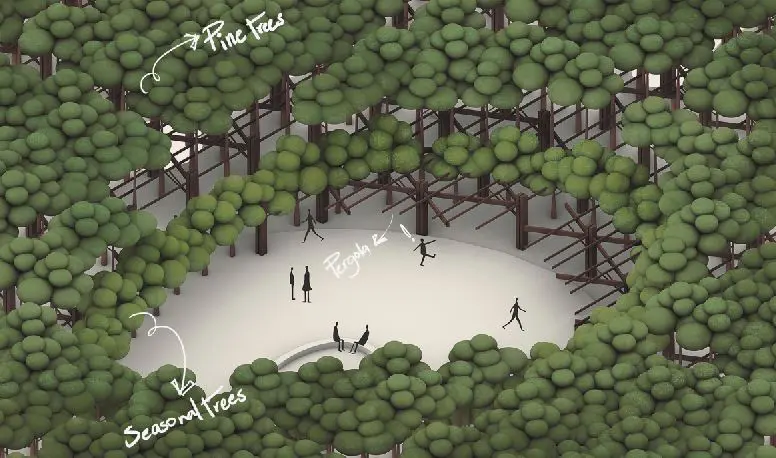

University : Damascus University
Tutor(s) : Wael Samhouri
Project Description
The site located in the modern Part of Damascus city in Syria. On city plan scale the site is a part of a green axis along “Barada” river which deteriorated in the past 50 years as a result of non-environmental activities causing the axis to have intermits.
Now the site acts as a rapture in the body of the green axis.
Until the beginning of 20th century the site was a flat grassy plain that Damascene people used to call it “Marjet Alhasheesh” and use it as a place to have their picnic) this was a tradition called “Siran”.
in 1950’s the site was used to hold Damascus International Fair which led to burry “Marjet el Hasheesh” green land under a layer of tar from 70 years till now in order to build the fair’s pavilions.
In 2006 the fair was moved to another site and “Majet AlHasheesh” was neglected until 2010 when the government decided to turn it into a park dedicated to a new, huge, rose-like concrete building (Massar
Rose) – (an incubator for kids activities) which took10% of “Marjet AlHasheesh”.
Due to war, the project stopped after constructing only the structural elements of the rose.
Today the need to think of other plans is rising especially aftermath.
By Noticing:
1-how Damascus City lost its green “Marjet AlHasheesh” and more than 90% of trees in
its urban context
2- the fact that What is called the city center of Damascus now, was a piece of nature in the past consisting of a river, green plain and a huge mass of ever green trees…
The concept of my project came to bring back the lost “Marjet Alhasheesh” and compensate the lost green mass of the whole context inside “Marjet hasheesh” in an exaggerated way. The project proposes an Urban-man made forest in “Marjet al Hasheesh”.
The site located in the modern Part of Damascus city in Syria. On city plan scale the site is a part of a green axis along “Barada” river which deteriorated in the past 50 years as a result of non-environmental activities causing the axis to have intermits.
Now the site acts as a rapture in the body of the green axis.
Until the beginning of 20th century the site was a flat grassy plain that Damascene people used to call it “Marjet Alhasheesh” and use it as a place to have their picnic) this was a tradition called “Siran”.
in 1950’s the site was used to hold Damascus International Fair which led to burry “Marjet el Hasheesh” green land under a layer of tar from 70 years till now inoder to build the fai’rs pavilions.
In 2006 the fair was moved to another site and “Majet AlHasheesh” was neglected until 2010 when the government decided to turn it into a park dedicated to a new, huge, rose-like concrete building (Massar
Rose) – (an incubator for kids activities) which took10% of “Marjet AlHasheesh”.
Due to war the project stopped after constructing only the structural elements of the rose.
Today the need to think of other plans is rising especially aftermath.
By Noticing:
1-how Damascus City lost its green “Marjet AlHasheesh” and more than 90% of trees in its urban context
2- the fact that What is called the city center of Damascus now, was a piece of nature in the past consisting of a river, green plain and a huge mass of ever green trees…
The concept of my project came to bring back the lost “Marjet Alhasheesh” and compensate the lost green mass of the whole context inside the “Marjet hasheesh” in an exaggerated. The project proposes an Urban-man made forest in “Marjet al Hasheesh”.
What if we spread a layer of thousands of trees on “Marjet AlHasheesh” that grows over years considering?
1- the tree as an architectural structure and element (canopy, Roof, wall, pillars…ect)
2- grouped planted trees as a matter and mass that we use to Enclose (carve) Urban spaces.
3- trees as a building material that an architect can use instead of regular materials when building on a green land
is not an environmental – ethical decision?
4- how can the process of the proposed forest reflect the language that an architect can use to design using trees
compared to the language of landscape architects?
Imagine a city that have a forest at its heart, a lung to breath during the age of COVID-19, a vent away from
exhausting city life, an escape from war left overs, a green place to heal the city and its inhabitants who had
been suffering from conflicts and gathering them again in a revived mother nature’s womb.
Established in 2012, Tamayouz Excellence Award is an unaffiliated, independent initiative that aims to advance the profession of architecture academically and professionally. Tamayouz is dedicated to supporting aspirational and transformative projects that tackle local and global challenges and that are informed by a holistic understanding of context.